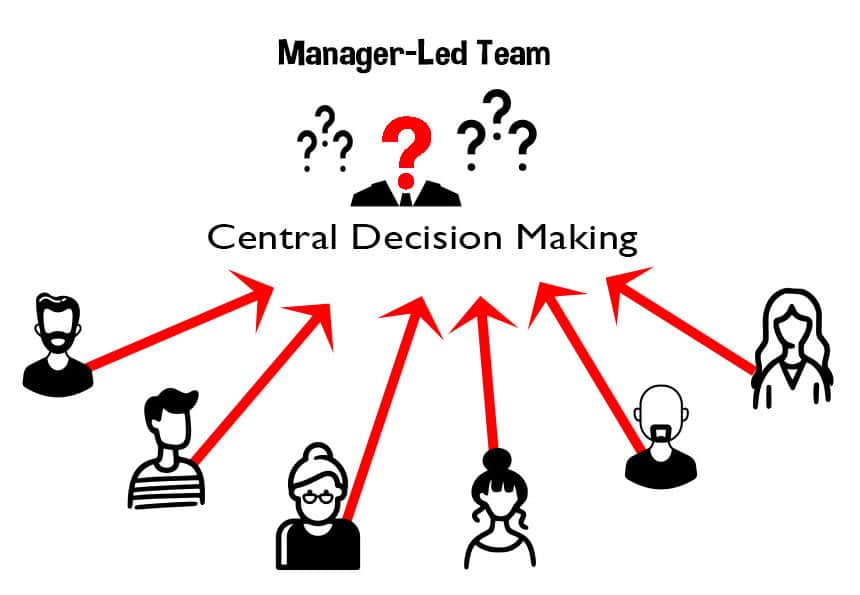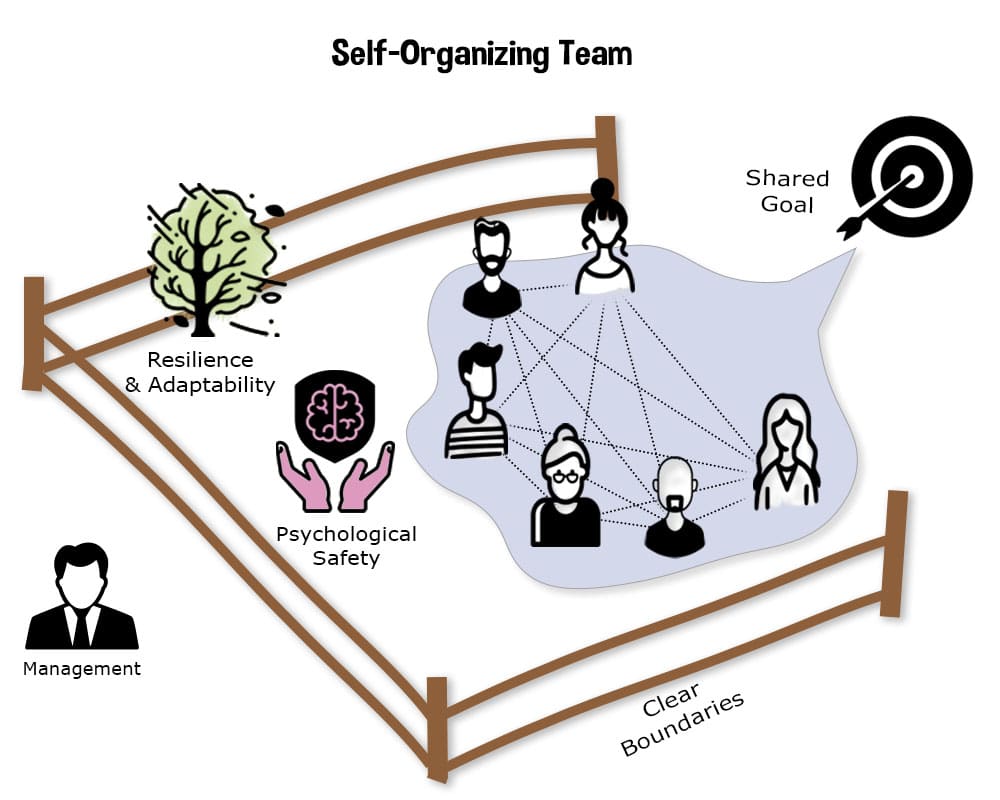A self-organizing team is one where team members make all relevant decisions on how to achieve their goals. Contrary to the beliefs some people hold, self-organization isn’t a free-for-all where chaos reigns and there is no responsibility. Instead, it very much relies on the engagement, self-discipline, and focus of the team members. Self-organizing teams don’t lack leadership or roles; rather, these attributes emerge and change over time within the team itself instead of being appointed by an outside force (the fancy label is “emergent structure”). The person who provides leadership in one moment may not be the best suited for the next, so in a truly self-organizing team, roles change, often rapidly.
Benefits of Self-Organization
- Increased Motivation and Engagement – Motivational models that we commonly refer to (e.g. ARC, SCARF) make Autonomy a central pillar. Self-organization teams are one way to grant people that Autonomy at work. This Autonomy leads to increased motivation and engagement. It’s empowering in many positive ways to not have rigid structure imposed on you from external viewpoints.
- Resilience and Adaptability – When circumstances change unexpectedly, self-organizing teams adapt far more quickly, in part because they’re not idly waiting for direction from others (e.g. an unknown requirement from a customer, major local disaster, global pandemic)
- Complexity – Manager-led teams struggle to deal with problems that require more knowledge, depth or perspective than a single person can encompass. (See: Complexity) As complexity increases in the world of work, manager-led teams are having an increasingly difficult time.
- Creativity – Being responsible for achieving a goal, and having access to many minds, means the self-organizing team often finds more innovative solutions to problems than what a centrally-led team could produce.
- Collaboration – Shared responsibility and decision making mean that team members talk more often. Increased communication gives us better knowledge of what our peers are working on and how we can help.
- Learning and Cross-Skilling – When we work closely with people of different skills and backgrounds, we learn through observation and direct instruction. By expanding our own knowledge and skills in this way, more options are available to the team as a whole, and impediments are reduced. Another positive by-product is increased comradery and communication. As we see the challenges that people in other roles face, we have more empathy for them when things get difficult.
- Speed and Effectiveness – As the team learn to work well together, they will outperform a manager-led team. Even more importantly, a self-organizing team will do a better job of delivering high-quality solutions to customers’ actual problems, as opposed to cranking more widgets out the door faster.
Making Self-Organization Work
Self-organizing teams need both support and space from management to be able to function effectively. In particular, management need to make the team’s Goal clear, and they also need to set decision-making boundaries.

Without a Common Purpose and commitment, team members have no reason to break out of their silos.[1] In the game of Scrum, their Product Vision is the long-term part of the goal and product strategy is the medium-term goal. Best case scenario, the team members are involved in co-creating the Vision with the stakeholders, so they feel a sense of ownership in addition to having a deeper and clearer understanding.
No team will succeed without Psychological Safety. Okay, but what does that mean? Psychological safety is knowing that I if try something and it fails, it won’t be held against me. Teams with Psychological Safety are also able to learn more rapidly. (Actually, I suspect that teams without a culture of safety don’t learn much at all.)
Creating a Learning Environment is a key step to making the team work effectively. Scrum builds in learning everywhere if our team only takes the time to breathe and notice. Refinement and Sprint Review provide product-focused learning, Retrospective gives the team a chance to learn about improvement opportunities, and Daily Scrum helps create both types of learning.
Finally, leaders and experts should start asking open-ended questions. This sends the signal that they’re not presupposing solutions and aren’t imposing their ideas on the team.

Challenges to Becoming a Self-Organizing Scrum Team
- Traditional Hierarchy – When anyone in the chain of command asserts their “right” to make a decision that was inside the team’s decision-making boundary, the team members learn that they’re only self-organizing up to certain point, and then must wait for the adults. This is demoralizing and demotivating.
- Matrix Management – This is when we create teams that are self-organizing but the team members report to different managers. Classic example: a product development team staffed with Business Analysts, Software Developers and Quality Assurance. Each part of the team is reporting to a different manager and each manager has their own needs. Rarely do these managers’ needs align well with the Product Goal.
- Old Habits – Some people have 20 – 30 years of work experience waiting for someone to tell them what to do. It will take time and coaching support for them to take back their autonomy.
- Dominant Personality – People who have dominant and outgoing personalities may feel that it is appropriate for them to take leadership in a team. Most are not doing this maliciously or intentionally, it is just an expression of their nature. In these cases the ScrumMaster will need to coach privately and use facilitation techniques that give everyone equal voice. (Beware. There are some people who read Machiavelli and thought it was a text book. Those people don’t belong in a team.)
The best Scrum Masters don’t solve their team’s problems. Instead, they encourage self-organization and help team members see where the problems are, then get out of the way. Only when the team can’t resolve the problem themselves does the Scrum Master step in, usually to escalate or ask for outside help.
Resource Links:
- 5 Challenges Facing Self-Organizing Teams
- Creative Forces for Self Organizing Teams
- Empowering Team Autonomy: Cultivating Self-Organizing Teams
- Foundations of Self-Organization
- Guiding Agile Teams Towards Self Organization
- Navigating Self-Organization in Agile Teams: A Journey through Ashby’s Law
- The Science of Self-Organization and Adaptivity
- Self-organization, and how it can be improved through team composition
- Self-Organizing Teams
- Self-Organizing Teams: A Complete Guide
- So — What Exactly is “Self-Organized”?
- What Are Self-Organising Teams?
*Thank you for visiting the World's Largest Opinionated Agile Reference Library. This content is created and the links are curated through the lens of Agile Pain Relief Consulting's view of what is effective in the practice of Scrum and Agile. We don't accept submissions and emails to that effect are marked as spam. Book listings may use affiliate links that could result in a small commission received by us if you purchase, but they do not affect the price at all. From experience, this won't amount to anything more than a cup of coffee in a year.« Back to Glossary Index